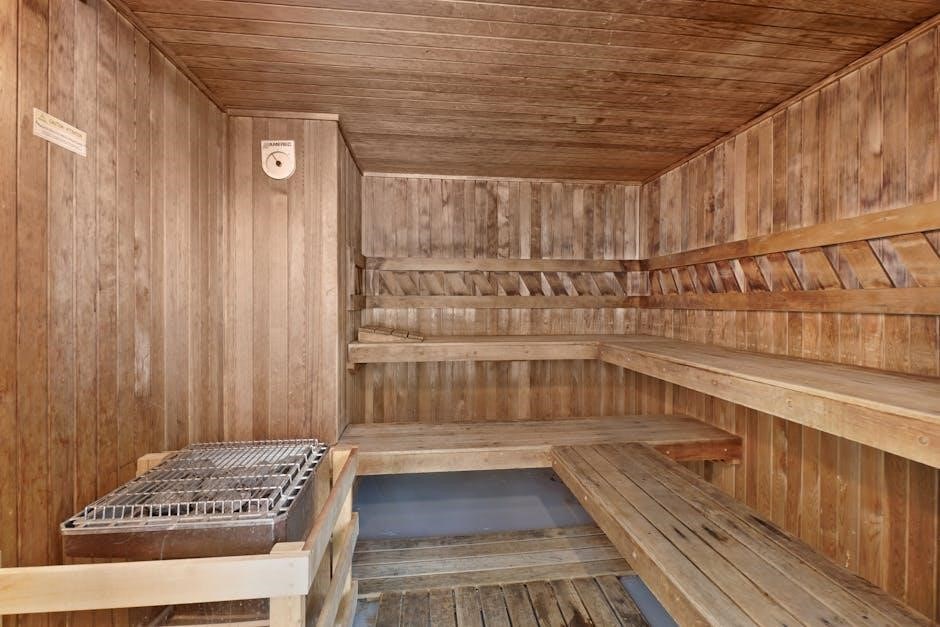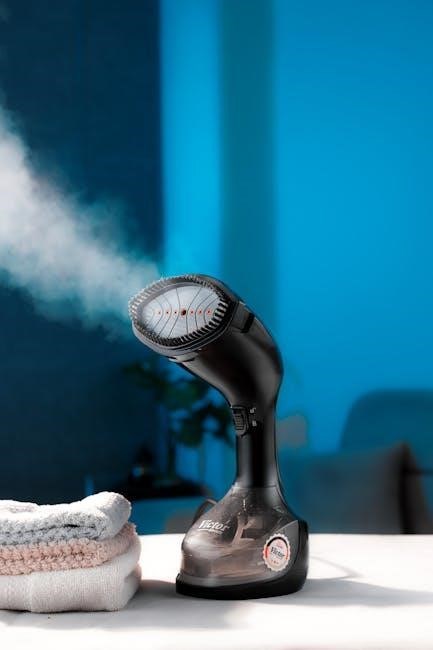Radiant floor heating offers unparalleled comfort by circulating heated water or electricity beneath floors. It’s energy-efficient‚ quiet‚ and provides consistent warmth. Ideal for modern‚ eco-friendly homes.
What is Radiant Floor Heating?
Radiant floor heating is a system that circulates heated water or electricity beneath flooring to warm spaces. It operates by transferring heat directly to objects and people‚ creating a comfortable environment. This method is highly efficient‚ as it eliminates air drafts and heats evenly. Radiant systems can be hydronic (water-based) or electric‚ offering flexibility for various applications. Unlike traditional heating‚ it doesn’t rely on air circulation‚ making it ideal for maintaining consistent temperatures quietly and effectively. It’s a modern‚ sustainable solution for homes and buildings seeking energy-efficient warmth.
Benefits of Radiant Floor Heating
Radiant floor heating offers exceptional comfort‚ energy efficiency‚ and design flexibility. It provides even heat distribution‚ eliminating cold spots and drafts. By warming objects directly‚ it reduces heat loss and allows lower thermostat settings‚ cutting energy costs. The system is quiet‚ invisible‚ and free from allergens like dust. It works seamlessly with various flooring materials and is ideal for zoned heating‚ giving precise temperature control. Radiant heating also increases property value and is a sustainable‚ eco-friendly option for modern homes‚ making it a preferred choice for those seeking lasting comfort and efficiency.

Types of Radiant Floor Heating Systems
Radiant floor heating systems include hydronic and electric options. Hydronic systems circulate heated water‚ while electric systems use heating elements. Both provide efficient‚ consistent comfort.
Hydronic Radiant Floor Heating
Hydronic radiant floor heating uses heated water circulating through PEX tubing to warm spaces. It’s energy-efficient‚ operates at lower temperatures‚ and can integrate with boilers or water heaters. This system is ideal for large areas and offers zoned heating control. Installation involves laying tubing in concrete slabs‚ under floors‚ or within joist spaces. Maintenance is minimal but requires checking for leaks and ensuring proper water temperature. Hydronic systems are durable and provide consistent‚ comfortable heat‚ making them a popular choice for both residential and commercial applications.
Electric Radiant Floor Heating
Electric radiant floor heating uses resistance heating cables or mats to warm floors. It’s ideal for smaller spaces‚ bathrooms‚ or retrofit projects. Installation is straightforward‚ often involving laying cables in thinset mortar under tile. Electric systems are noise-free and require no plumbing‚ making them a convenient choice. They operate independently‚ offering precise temperature control. However‚ higher electricity costs can be a drawback. Electric radiant heating is a versatile option for targeted warmth‚ providing quick response times and ease of use‚ suitable for various flooring materials like tile and stone.

Design Considerations
Design considerations involve heat loss calculations‚ tubing layout‚ spacing‚ and flooring material selection. Proper insulation and system balancing ensure efficiency and even heat distribution;
Heat Loss Calculations
Heat loss calculations are crucial for determining the radiant floor heating system’s requirements. They involve assessing factors like insulation‚ window sizes‚ and climate to ensure the system can handle maximum heat loss‚ typically during the coldest weather. Accurate calculations prevent under-sizing or over-sizing the system‚ which can lead to inefficiency or higher costs. Tools like LoopCAD software aid in precise room-by-room heat loss analysis. Factors such as U-factors for windows‚ insulation R-values‚ and infiltration rates are considered. Professional guidance ensures accurate results‚ optimizing system performance and energy efficiency.
.Flooring Material Selection
Flooring Material Selection
Flooring material selection significantly impacts radiant floor heating efficiency. Ceramic tile‚ porcelain‚ and natural stone are excellent choices due to their high thermal conductivity. These materials efficiently transfer heat and are durable. Avoid carpet‚ thick rugs‚ and wood flooring with high insulation properties‚ as they reduce heat transfer. Proper material selection ensures optimal system performance and comfort. Always consult manufacturer guidelines for specific material compatibility and recommendations. This ensures your radiant floor heating system operates efficiently and meets your heating needs effectively.
System Components
A radiant floor heating system includes key components like boilers‚ manifolds‚ PEX tubing‚ and controls. These elements work together to distribute heat efficiently and reliably.
Boilers and Heat Sources
Boilers are central to hydronic systems‚ providing heated water for circulation. Modern boilers are highly efficient‚ operating at lower temperatures ideal for radiant heating. They can be fueled by natural gas‚ propane‚ or electricity. Some systems use dedicated water heaters instead of traditional boilers‚ offering cost-effective solutions. The choice of heat source depends on energy availability‚ budget‚ and system design requirements. Proper sizing ensures optimal performance and energy savings.
Manifolds and Distribution Systems
Manifolds are essential for distributing heated water to different zones in a radiant system. They regulate flow rates and pressure‚ ensuring even heat distribution. Modern manifolds offer precise control‚ allowing zoning customization. Distribution systems‚ including PEX tubing‚ are designed for flexibility and durability. Proper manifold sizing is critical to handle the required flow rates efficiently. Well-designed distribution systems ensure consistent heating and minimize energy losses‚ making them a cornerstone of effective radiant floor heating setups.
PEX Tubing and Installation
PEX tubing is a flexible‚ durable option for radiant systems‚ resistant to leaks and corrosion. It’s installed in concrete slabs or under floors‚ requiring precise spacing for uniform heat. Proper installation ensures efficiency and longevity. Tubing layouts must consider room size‚ heat loss‚ and flooring material. Installers often use grids or mats for even distribution. PEX is ideal for hydronic systems due to its adaptability and reliability. Correct installation practices‚ including insulation and pressure testing‚ are crucial to optimize performance and minimize potential issues over time.
Controls and Thermostats
Controls and thermostats are essential for optimizing radiant floor heating systems. They regulate temperature‚ ensuring comfort and efficiency. Advanced thermostats allow zoning‚ enabling different areas to maintain unique settings; Programmable models adapt to schedules‚ reducing energy use. Sensors monitor floor and air temperatures‚ preventing overheating. Smart systems integrate with home automation for remote control. Proper installation and calibration ensure precise performance. Thermostats with floor-sensing capabilities protect flooring from damage. Regular maintenance of controls ensures long-term reliability and optimal system operation‚ making radiant heating both efficient and user-friendly. Modern controls enhance the overall experience‚ offering customization and energy savings.

Installation Steps
Installing radiant floor heating involves preparing the site‚ laying tubing‚ connecting the system‚ and testing. Proper execution ensures efficiency‚ safety‚ and long-term performance‚ following detailed guidelines for optimal results.
Preparing the Site
Site preparation is critical for a successful radiant floor heating installation. Clear the area of debris‚ inspect for obstructions‚ and ensure the floor is level. Verify proper drainage and insulation to prevent heat loss. Check for any underground utilities and mark their locations. Ensure the subfloor is clean‚ dry‚ and structurally sound. Address any moisture issues to avoid system inefficiencies. Proper preparation ensures optimal heat distribution and system performance‚ making it a foundational step in the installation process.
Laying the Tubing
Laying the tubing is a precise process in radiant floor heating. PEX tubing is typically used for its flexibility and durability. Tubes are installed in loops‚ spaced evenly‚ and secured with clips or ties. The layout depends on the room’s heat loss requirements and desired comfort levels. Proper spacing ensures uniform heat distribution‚ while minimizing loops prevents pressure drops. Tubing should be protected from sharp objects and installed at the correct depth. Careful planning and execution during this step are crucial for system efficiency and long-term performance.

Connecting the System
Connecting the system involves linking components like boilers‚ manifolds‚ and pumps. Ensure all connections are secure to prevent leaks. Use appropriate fittings for tubing to maintain flow. Manifolds distribute water evenly‚ while pumps ensure optimal circulation. Thermostats and controls are connected last for precise temperature management. Testing each connection is essential to avoid future issues. Proper installation ensures efficient operation and maximizes system longevity‚ providing consistent warmth and comfort throughout the space. Attention to detail during this phase guarantees a reliable and durable radiant heating setup.
Testing and Commissioning
Testing and commissioning ensure system functionality and safety. Start by pressurizing the system to check for leaks. Use a pressure test kit to verify tubing integrity. Once leaks are ruled out‚ activate the heat source and circulate water through the loops. Monitor temperature using gauges to ensure even distribution. Test thermostats and controls to confirm proper operation. Flush the system to remove debris. Finally‚ perform a full-system test under normal operating conditions to ensure everything works seamlessly. Proper commissioning guarantees efficiency‚ safety‚ and optimal performance of the radiant heating system.
Maintenance and Troubleshooting
Regular maintenance ensures optimal performance. Check for leaks‚ inspect tubing‚ and maintain proper water quality. Troubleshoot issues like uneven heating or system noises promptly to prevent damage.
Routine Maintenance
Routine maintenance is essential for optimal radiant floor heating performance. Inspect tubing for leaks‚ check water quality‚ and balance the system annually. Ensure thermostats function correctly and maintain proper insulation. Clean or replace filters in heat sources regularly. For hydronic systems‚ test water pressure and treat water to prevent corrosion. Electric systems require checking connections and ensuring mats or cables are undamaged. Regularly review heat loss calculations to adapt to changing needs. Address minor issues promptly to avoid costly repairs. Keep detailed maintenance records for future reference and system longevity.
Common Issues and Solutions
Common issues with radiant floor heating include uneven heat distribution‚ system leaks‚ and thermostat malfunctions. Solve uneven heating by adjusting tubing spacing or flushing the system. Leaks often occur at connections and can be repaired with sealants or replacing faulty parts. Thermostat issues may require recalibration or replacement. Air in the system can cause noise and inefficiency; bleed the lines regularly. Corrosion in hydronic systems can be prevented with water treatment. Electric systems may need cable or mat replacements if damaged. Always refer to manufacturer guidelines for specific solutions to ensure system longevity and efficiency.
Radiant floor heating offers a comfortable‚ efficient‚ and visually appealing heating solution. Both hydronic and electric systems provide consistent warmth with minimal energy waste. Proper design‚ installation‚ and maintenance ensure optimal performance. Regular checks on tubing‚ thermostats‚ and connections prevent common issues. By following guidelines and addressing potential problems early‚ homeowners can enjoy long-term comfort and energy savings. This guide provides a comprehensive overview to help you design and maintain a radiant floor heating system effectively‚ ensuring a cozy and sustainable living space for years to come.



0 Comments